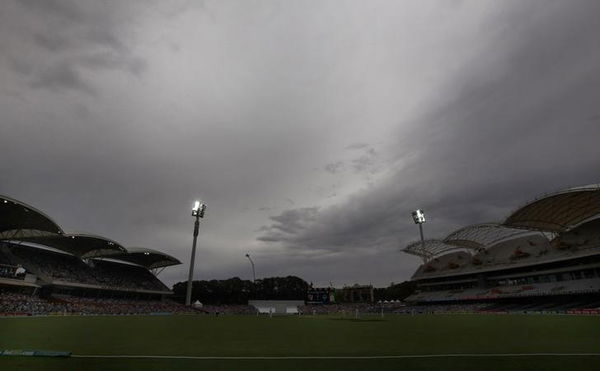
via Reuters
Storm clouds gather above the stadium during the fourth day’s play in the second Ashes cricket test between England and Australia at the Adelaide Oval December 8, 2013. REUTERS/David Gray/Files

via Reuters
Storm clouds gather above the stadium during the fourth day’s play in the second Ashes cricket test between England and Australia at the Adelaide Oval December 8, 2013. REUTERS/David Gray/Files
By Ian Ransom
MELBOURNE (Reuters) – Whether the catalyst for a full-scale revolution or a more gentle evolution, the inaugural day-night test between Australia and New Zealand should lead to irrevocable change for cricket’s oldest and most hallowed format.
Traditionalists have decried the concept and players on both teams have concerns about the fitness of the pink ball to be used in the match at Adelaide Oval.
ADVERTISEMENT
Article continues below this ad
Some fingers will inevitably be crossed when the lights flood down at the venue, where some of cricket’s most powerful officials will be among a crowd of some 40,000 people during the day’s first play.
However, like anxious parents fussing over their child on a school morning before the class photo, Australia’s cricket board has gone to great lengths to ensure the match puts on its best face for the cameras.
Over seven painstaking years have been devoted to the development and testing of Kookaburra’s pink ball but the match has still seemingly arrived in a hurry.
The concept has had top-level endorsement from the International Cricket Council since 2012, but Cricket Australia led by chief executive James Sutherland has been its most steadfast champion for over a decade.
The Adelaide Oval, recently redeveloped into an ultra-modern stadium, has been hand-picked to host the match and appears an inspired choice as both a reliable tourist magnet and being resistant to the dew that plagues other venues at night and can play havoc with the behaviour of a ball.
‘Ashes-style’ crowds are expected to attend the 53,500-capacity ground through the opening days and the weekend, with many curious interstate visitors intrigued by the novelty factor of seeing players in traditional whites grapple with a pink ball.
Ground-staff have also done their best to ensure bowlers have more sway in the battle between bat and ball which has been hopelessly skewed towards the batsmen in the opening two matches of the series in Brisbane and Perth.
A green tinge will give hope to both teams’ pacemen that there may not be a repeat of the bruising run-fests they were subject to in the earlier matches.
“We just feel very confident now that it behaves in the same manner as the red ball does,” South Australia Cricket Association Chief Executive Keith Bradshaw told Reuters in an interview on Wednesday.
“There have been comments from time to time but what we’re seeing now is more and more positive comments,” he said of the players’ feedback.
“The statistics would say that we’re ready to go.”
Players have warmed to the concept after a recent round of domestic Sheffield Shield matches helped ease concerns after the performance of the ball during the tour match in Canberra.
Australia batsman Adam Voges remarked that the ball, which was heavily battered by the abrasive Manuka Oval pitch had turned “green”, raising concerns about the welfare of players unable to see the ball properly.
The ball performed far better in the recent Shield match at the Adelaide Oval between New South Wales and South Australia, with Australia captain Steven Smith relieved by its endurance.
The match has naturally delighted host broadcaster Channel Nine, as it offers a chance for test cricket to go into prime-time viewing.
CAUTIOUS ENDORSEMENT
Australia’s players’ association has also offered its cautious endorsement but is less bullish about the concept than Cricket Australia which has invested heavily in it.
“We’ve always seen this as an initiative and after this test I think it’s important that players’ views are represented as to whether day-night test cricket goes on into the future,” Australian Cricketers’ Association chief executive Alistair Nicholson told Reuters.
“That’s important in the washup that we have that input from the players and their safety’s involved in that. There’s probably a bigger debate worldwide about where it sits.”
Though still popular in Australia and England, tests have struggled to draw crowds in the emerging markets including cricket powerhouse India even as the limited overs formats of one-day and Twenty20 have soared in popularity.
ADVERTISEMENT
Article continues below this ad
Cricket Australia have invited a number of officials from other nation’s boards to watch the game in Adelaide and members of the MCC World Cricket Committee will also attend after a two-day meeting on Wednesday and Thursday.
Most officials dare not question test cricket as being the pinnacle of the game, yet few have produced answers as to how to guarantee its relevance in future.
“When I was involved with the MCC World Cricket Committee and the ICC cricket committee many years ago, we certainly had concerns, not so much at that point of time with Australia and the UK, but certainly on the subcontinent with dwindling numbers,” said Bradshaw.
ADVERTISEMENT
Article continues below this ad
“So we felt that day-night test cricket would be a good initiative. We’re at the start of a journey, not the end of a journey.”
(Editing by Sudipto Ganguly)
ADVERTISEMENT
ADVERTISEMENT
ADVERTISEMENT
ADVERTISEMENT

